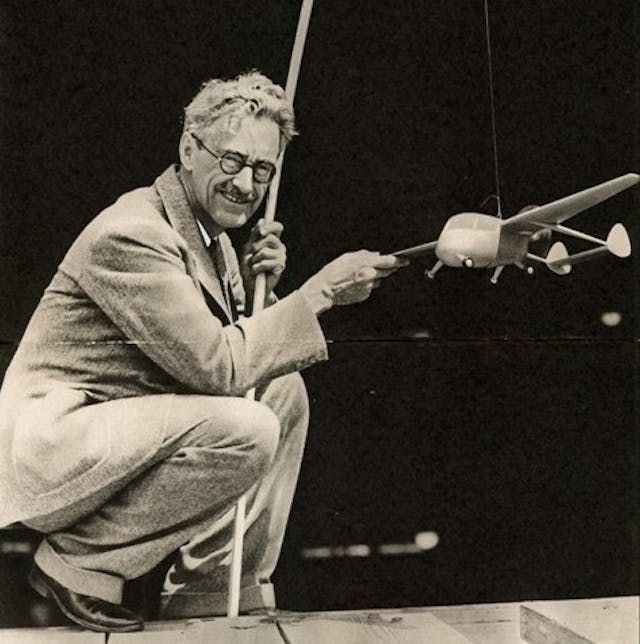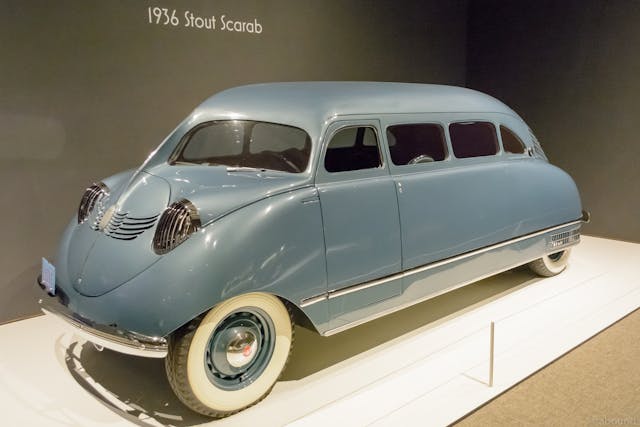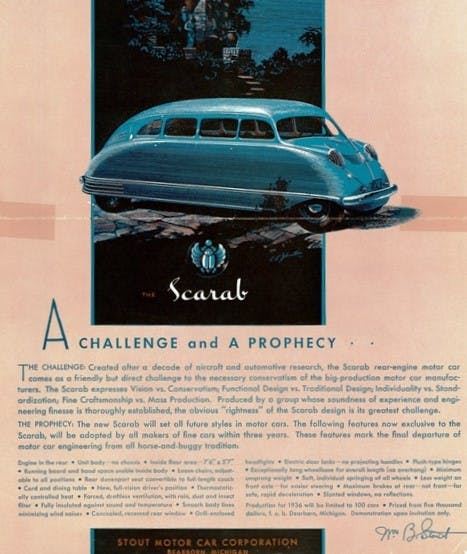Media | Articles
The groundbreaking 1930s Stout Scarab was the first—and coolest—minivan
“The world’s first minivan.” Few automotive honors are less sexy than that dubious title. Unless, of course, you look like the 1930s Stout Scarab. The Art Deco, aerodynamic, head-turning multi-passenger vehicle created a stir eight decades ago. Its powers have not waned.
Designed and built by engineer William B. Stout, the Scarab’s shape not only resembled the beetle for which it was named, but it also aptly represented what Egyptians believe about the winged insect—that it symbolizes rebirth and renewal. Appropriately enough, Bill Stout did a whole lot of rebirthing and renewing in his day, both before and after the Scarab.
Long before creating the futuristic vehicle, which was produced from 1934–39, Stout’s resume included work as chief engineer for the Schurmeir Motor Truck Company, automobile and aviation editor for the Chicago Tribune, and chief engineer at Scripps-Booth Automobile Company. In 1916, Stout was lured away from Scripps-Booth by Packard Motor Car Company President Alvan Macauley, who named him chief engineer of Packard’s aviation division. Three years later, Stout left to start his own engineering company in Dearborn, Michigan.

Considered the “father of modern aviation,” Stout was the first to endorse an all-metal airplane as a superior alternative to the standard construction of early 20th century aircraft, in which fabric was stretched over a wood frame. He also founded America’s first scheduled airline, Stout Air Service, which later became United Airlines. And he created the successful Ford Trimotor commercial airplane, improving upon his own early designs.
Although Stout loved aviation, he became frustrated by the overall lack of innovation in the industry and turned his attention to other forms of commercial transportation. That led to a very different and definitely innovative vehicle: the Scarab.
Marketplace
Buy and sell classics with confidence

The long, bulbous Scarab wore aluminum skin that was riveted to an aluminum space frame, much like an airplane, and it resembled the 1933 Dymaxion or perhaps even an Airstream camper. It featured a 135-inch wheelbase and had an overall length of just over 16 feet. By placing the engine in the rear, Stout’s rear-wheel-drive Scarab offered more leg room for its driver and passengers. Its all-wheel independent suspension accounted for a smooth and stable ride, and it had hydraulically operated cast-iron drum brakes.
Among the Scarab’s exterior features, all created with aerodynamics in mind, were fenders that were incorporated into the body, rear-wheel skirts, deleted running boards, hidden door hinges, and flush glass.

“The driver will have infinitely better vision from all angles,” Stout wrote in the Scientific American in 1935. “The automobile will be lighter and more efficient and yet safer, the ride will be easier, and the body will be more roomy without sacrificing maneuverability.”
Inside, only the driver’s seat was fixed. The others could be turned up to 180 degrees to face each other, and there was a fold-down table for meals or to play games. The cabin also offered cutting-edge amenities like a dust filter to enhance the inside air, interior lighting, thermostat-controlled heat, and power door locks. Only the driver’s door was located in its conventional place; passengers entered and exited through a central, push-button passenger door. The ceiling was covered in wicker-looking lacewood, front to back.

The Scarab was powered by an 85-horsepower Ford flathead V-8, mated to a three-speed manual transmission. It could accelerate from 0–60 mph in 15 seconds and had a top speed of about 80 mph. With the engine located in the rear, there was a storage compartment up front to hold luggage and a spare tire.
In a 1935 magazine advertisement titled “A Challenge and a Prophecy,” Stout predicted the Scarab would be a big seller, acknowledging it offered a clear break from the industry herd. “Created after a decade of aircraft and automotive research, the Scarab rear-engine motor car comes as a friendly but direct challenge to the necessary conservatism of the big-production motor car manufacturers. The Scarab expresses Vision vs. Conservatism. Functional Design vs. Traditional Design. Individuality vs. Standardization. Fine Craftsmanship vs. Mass Production.”

Another advertisement announced that 1936 production of the hand-built Scarab would be “limited to 100 cars,” starting at $5000. That’s nearly $100,000 today. Considering America was still fighting its way out of the Great Depression at the time, it’s no wonder that only nine Scarabs were built prior to World War II, regardless of its innovations. Nearly all of those vehicles went to members of the board of directors, which included Phillip Wrigley and Harvey Firestone. Only five Scarabs exist today.
Following WWII, Stout attempted to resurrect the vehicle with a fiberglass-bodied Stout Scarab Experimental (Project Y), but with an estimated price tag of $10K apiece ($140K), the new Scarab never went into production.
If the groundbreaking Scarab looks and sounds like the perfect vehicle for a family road trip, you now know why it’s often referred to as the first minivan. You also know it’s a lot more than that.
















Pretty sure he did not start United Airlines
Didn’t start UA, but did contribute to its success. According to Wikipedia, In “1929, Stout sold Stout Air Services to United Airlines”.
Awesome car. well before it’s time, Only the price held it back, I like the idea it had a Ford Flat Head.
In other Stout news…
Stout is remembered for his engineering credo, “Simplicate and add more lightness.” This would later become best known as the adopted maxim of Colin Chapman of Lotus Cars. It actually originated with Stout’s designer Gordon Hooton. (From Wikipedia)
One of the earliest examples of gaining interior room by pushing the wheels out to the corners of the car.
What goes around come around. Looks like it has about the same outward visibility as a modern SUV.
It’s a cool idea. It was just too expensive for it’s time to truly become a thing.
Fun article, fun car…One of these cars can be seen at the Detroit Historical Museum along with a later model (40’s) prototype being at Gilmore museum in Hickory Corners, MI
So cool of a set up for the interior, plus a Flathead Ford, awesome vehicle way before its time. He was a true genius, more so than Howard Hughes.
One of the last surviving Scarabs is housed in a humble looking warehouse In s/e Wisconsin. I had the opportunity to get a up close look at it when the owner drove by me as I was leaving a small car show at a bowling alley. I followed him to a nearby gas station. As he fulled up his vehicle drew an instant crowd. The owner was friendly and loved to show off the vehicle. Even inviting pretty women to have a seat inside of the expansive immaculate interior. I found out later the owner had about 10 million worth of incredible autos in that warehouse. I was referred to a 20 year old speed channel video on you tube where the owner took the shows host on a tour of his collection. Great memory for me.
The aerodynamics & swivel seats 180°, rear mounted engine & Ford flathead 8 put it ahead of it’s time, the priceing killed it’s acceptance, as well as poor marketing. Still love the concept.